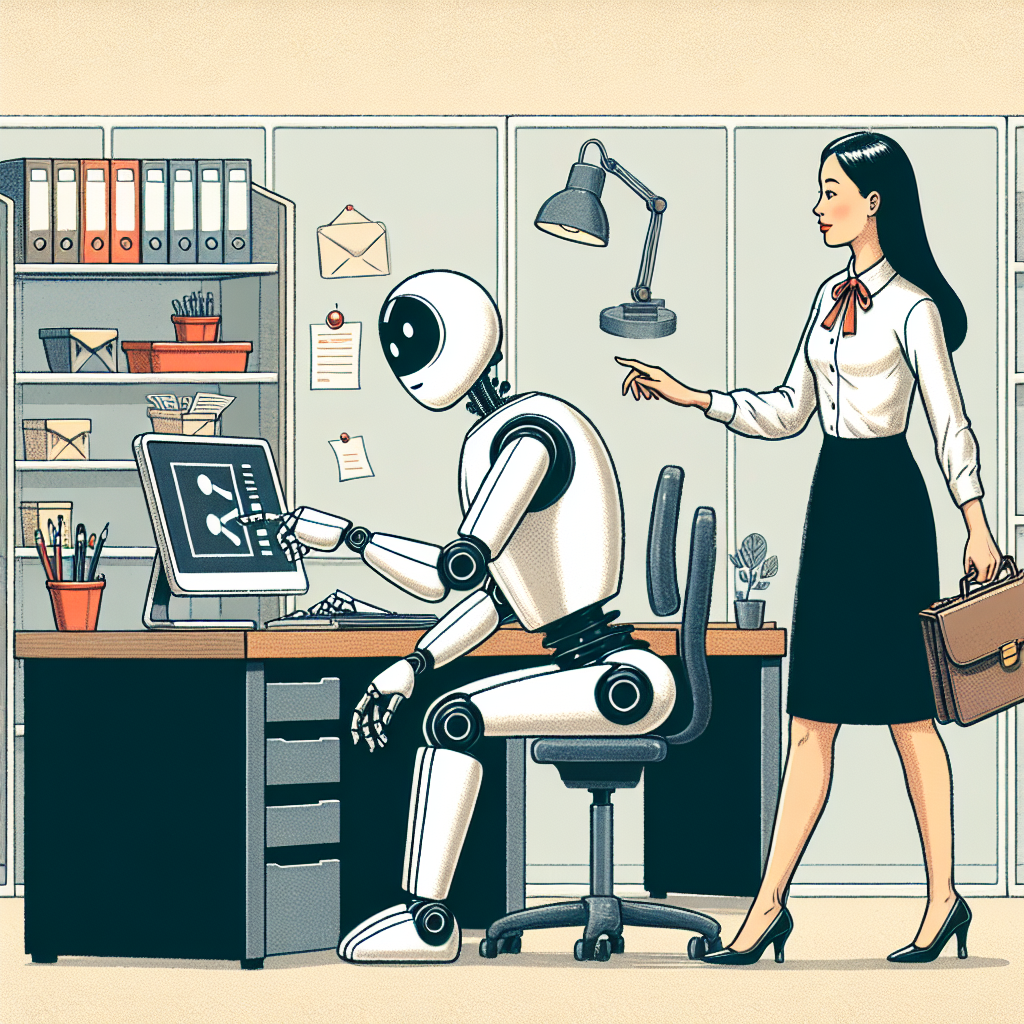In the ever-evolving business landscape, automation acts like a lynchpin, bringing order and efficiency. Business automation solutions are no longer a ‘nice to have,’ but as competition rises they will soon become, a ‘must-have‘ that streamlines business processes.
But it’s essential to strike a balance – the human touch should not be forsaken for efficiency.
The Continual Progression Towards Business Automation
The evolution of workflow automation has been remarkable, reshaping the landscape of the corporate world.
With the integration of machine learning algorithms and AI, various industries have witnessed a paradigm shift, challenging old norms and setting new standards.
This transformation has undeniably led to increased productivity and paved the way for more efficient growth strategies within businesses.
Nevertheless, it’s essential to recognize that adopting automation tools isn’t a quick fix for all operational challenges.
It requires a thoughtful and strategic approach, involving meticulous planning and precise execution.
Businesses must assess their unique needs and goals before implementing automation solutions. This involves understanding how automation can complement existing workflows and enhance overall efficiency.
By viewing automation as a tool to augment human capabilities rather than replace them, businesses can unlock new levels of innovation and competitiveness.
This requires ongoing evaluation, adaptation, and a willingness to embrace technological advancements while staying true to the core values and vision of the business.
However, despite the advantages, deploying automation tools for business isn’t a one-step remedy for all operational hitches. It’s a calculated move that needs careful planning and precision.
Decoding the Fear of Losing the Human Element
Many institutions have concerns about automation, worrying that it might take away the personal touch that makes their business special.
It’s true that machines are fast, efficient, and can reduce mistakes, but they can’t replace the human qualities of empathy and creativity.
However, there’s a positive side to automation that business owners should embrace. Automation is not meant to replace humans; rather, it’s here to support them.
Machines excel at handling repetitive tasks, which allows employees to focus on more important aspects of their work, like connecting with customers, coming up with creative solutions, and making strategic decisions.
By understanding the role of automation as a helpful assistant rather than a replacement, business owners can create a work environment where both technology and human skills thrive together, leading to greater productivity, innovation, and success.
The Vitality of Mundane Tasks in Business Operations
Mundane tasks, though underrated, play a critical role in business operations. They may be repetitive, but form the backbone of any organization.
However, when these tasks grow disproportionately, it ultimately hampers growth. This is where business automation solutions shine.
By automating mundane tasks, businesses can streamline operations, unleashing potential previously bogged down by manual processes.
The key is to harness the power of automation without compromising on the significant human elements of your business.

Case Studies: When Automation Meets Human Ingenuity
A vivid example of this harmonious blend of technology and human touch can be seen in the customer service industry.
Many firms have adopted AI chatbots to handle the more basic customer inquiries.
Though chatbots are managing the preliminary tasks, they seamlessly handover to a human agent as complexities arise.
This tactic has eliminated strain on customer service staff by quickly resolving FAQs and filtering the more complex problems where the company can provide that human touch.
Automation has played an important role for e-commerce giants like Amazon too. They employ automation for warehouse operations but rely heavily on human insight for strategic decisions.
These case studies flaunt the beneficial symmetry task automation can achieve when combined with strategic human attention.
Business automation has permeated every spectrum of corporate operations today, and its growth isn’t slowing down anytime soon. However, the key lies in balancing efficiency and empathy, machine and man.
Both entities bring unique abilities to the table. Machines bring speed and precision, while humans offer creativity and personal experience.
A perfect blend of these forces can unravel tremendous growth opportunities for businesses.
In the quest for business growth, automation is your friendly partner. Don’t perceive it as a replacement, but as a tool that complements human efforts.
In this user-friendly guide of automation, we have set the stage for the next big revolution – human-centric automation – a fusion of efficiency, growth, and empathy.
The Art of Delegation to Digital Helpers
Despite what one may think, not all tasks lend themselves to automation. It’s crucial to discern which tasks fit the automation bill.
These are typically repetitive tasks that require little to no decision-making capabilities, such as data entry or scheduling.
Fortunately, numerous automation tools for business exist to take over such tasks, freeing up your team’s time for more critical duties requiring human intervention.
Once you’ve defined what can be automated, familiarize yourself with the available automation solutions. Workflow automation software, Email marketing platforms, or CRM systems, to name a few, can significantly streamline business processes.
Also, remember that automation isn’t always about eliminating human involvement.
Sometimes, it’s about streamlining processes to assist your team, not replace them. Which brings us to our next point – the roadmap to seamless task automation.
The Roadmap to Seamless Task Automation
The key to implementing successful task automation lies in a carefully crafted strategy. List your needs, define your goals, and then select the automation solution that best meets these requirements.
- Step one – Evaluate your current processes. What tasks are consuming the most time? What tasks could potentially be automated?
- Step two – Research and select the right business automation solutions that cater to your specific needs.
- Step three – Implement the new technology slowly and in phases. Start by automating just one or two processes.
- Step four – Monitor the results, make adjustments as needed, and slowly expand the automation across other areas of your business.
Proactively adopting these best practices when implementing technology can save you from countless hours of stress accompanied by growth pains and can result in a thriving, streamlined business.
Keeping the Customer Experience at the Forefront
In the rush to automate, never forget who you’re doing it for – your customers. Keeping the customer experience at the forefront of your automation strategy is crucial for your business’s success.
Take your automated email system, for example.
While it’s great to have an automated response confirming a customer’s purchase or query submission, suppose a customer responds with a question.
In that case, they deserve to have a human response tailored to their specific needs, not another automated message.
Automation should enhance the customer experience, not detract from it. Remember that your customers are humans who desire connections with other humans, especially when they have specific questions or concerns.

Training Your Team to Work Alongside Automation
As you integrate more automation into your workflow, it’s crucial that your team understands the changes.
Employees should be educated about why new systems are being implemented and how they can best use them to their advantage.
Training should be a priority when adopting new automated systems. Keeping everyone on the same page during any change can be a challenge.
It’s important you invest the time to make sure your teams are comfortable and confident using new technology.
Moreover, businesses must build an environment that fosters a positive perspective toward automation. Employees feel anxious about automation when they see it as a threat to their jobs.
Frame automation as an ally that can take over mundane tasks, so that employees can focus on more meaningful, exciting work. With the right mindset, your workforce can navigate the new digital landscape.
In summary, businesses must remember that automation is not about replacing human efforts, but about enabling them to perform better.
The key lies in choosing the right tasks to automate, using the right tools, and never losing sight of the human touch. Only then can the true potential of business automation be realized.
Blending Automated Systems with Human Interaction
As much as automation streamlines operational efficiency, the human aspect in business interactions remains significant.
Merging automation tools for business with personal touchpoints can optimize performance and still maintain a warm rapport with clients and customers.
The strategy here lies in wisely choosing tasks to be automated and placing humans where they’re most effective.
AI might be excellent for managing incoming inquiries, but when interactions turn complex, it’s the humans that seamlessly take over. Automation, when put to use correctly can, in fact, improve human-to-human interactions.
Businesses can fully utilize their human resources for advanced strategic tasks, boosting overall productivity and customer satisfaction.
Measuring the Impact of Automation: Performance and Satisfaction Metrics
The effectiveness of business automation solutions isn’t baseless.
Evaluation and reassessment are integral steps in any new implementation process, especially in task automation.
Businesses can track performance increase and customer satisfaction levels through multiple KPIs (Key Performance Indicators).
For instance, look at the time saved in mundane tasks, lowered error rate, the volume of work processed and so on.
Simultaneously, analyzing customer interaction instances through satisfaction surveys or NPS (Net Promoter Score) can reveal how automation impacts the customer experience. Businesses can adapt and re-strategize based on this feedback, ensuring a perfectly balanced, high-performing workflow.
The Ethical Considerations of Automation
As businesses delve into automation, ethical dilemmas surface, notably regarding potential job displacement. It’s undeniable that automation can lead to job loss in certain areas.
However, a deeper analysis reveals that these lost jobs can be replaced with roles focused on utilizing AI alongside human input.
This shift prompts a critical question: Is it more advantageous to hire one person leveraging AI or five people to perform the same tasks?
The truth is, automation can streamline operations and reduce expenses, making businesses more competitive in the market.
By embracing automation responsibly, companies can operate with greater efficiency and lower expense rates, paving the way for growth and innovation while maintaining a workforce that leverages AI to enhance productivity.
Future-Proofing Your Business
Adopting automation in your business is not about being ‘with the trend‘. It’s about being ready for the future.
Even as technology continues to evolve at an unprecedented rate, companies need to remain rooted in their core values.
Businesses should strive to stay abreast with the latest advancements without losing sight of the human factor.
They should proactively look out for beneficial technologies, prepare for the next wave of innovation, and adapt quickly to maintain their competitive edge.
While preparing for future developments, it’s crucial not to overlook the importance of maintaining personal interactions and trust amongst your clients and customers.
Remember, human-centric automation is the future of modern businesses.
Striking the Perfect Balance
In conclusion, embarking on the automation journey of your business is undeniably critical to remain relevant.
But it’s equally vital to remember that the essence of business lies in human connections.
Sustainable growth will be witnessed by businesses who manage to blend the efficiency of machine intelligence with the empathy and intuition of humans.
Streamlining business processes through automation while maintaining human interaction will create a thriving, customer-focused business.
So as you ponder upon leveraging AI and automation in your business operations, remember that the underlying idea is not to make businesses impersonal and machine-like.
But rather, to free up the invaluable human potential that can focus on driving growth, creating innovative pathways and delivering superior value to your customers.
Keep the machines for the tasks they excel at. Save the humans for what they do best – inculcating trust, empathy, and creative thinking.
That’s how businesses will unlock unprecedented growth – a perfect blend of automation and the human touch.






